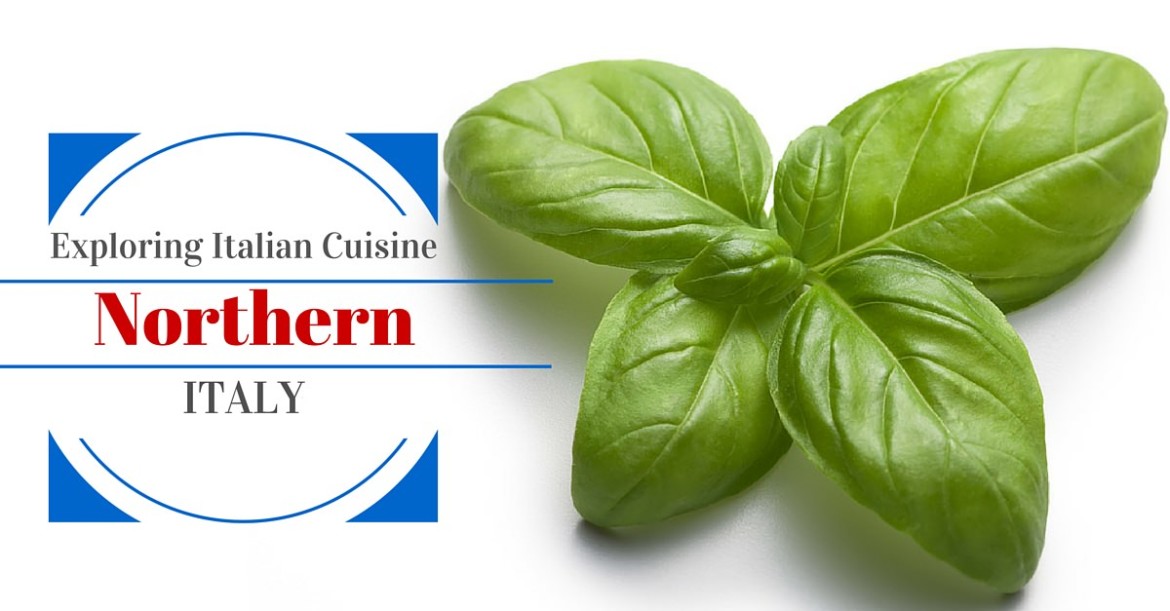- Tomatoes: A Taste of Summer - July 26, 2017
- The International Origins of Pasta - July 12, 2017
- A History of Italian Americans in Salt Lake City - June 29, 2017
Italy is a small country, but the characteristic “boot” shape stretches across an immense region, with the northern part sharing borders with France, Switzerland, Austria, and Slovenia, with the Mediterranean bordering its west coast, and with its east coast across the Adriatic Sea from Croatia, Bosnia and Herzegovina, Albania, and Greece. Italy’s regional cuisines express influences from both the geography and the country’s neighbors, while maintaining a distinct regional flavor. As a result, there is no singular “Italian cuisine.” We begin this exploration with Northern Italian cuisine.
Characteristics of Northern Italian Cuisine
Like other cuisines of the Alps, Northern Italian cuisine showcases richer fats from dairy, such as cream and butter, in addition to olive oil (as opposed the South where olive oil is more commonly used than butter). Herbs such as rosemary and sage are commonly used, perhaps an influence from northern neighbors. In addition to the ubiquitous pasta, Northern Italian cuisine uses staples such as rice and corn, featured in risotto and polenta. Situated across mountainous, woodsy terrain and fresh water, Northern Italian cuisine features a wide range of protein such as beef, veal, pork, rabbit, quail, fish, and shellfish (more popular on the coasts).
Val d’Aosta Region
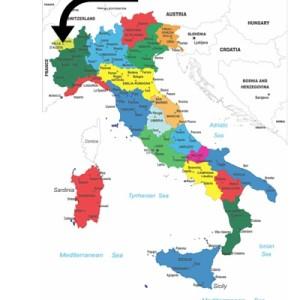 Far up north, tucked near the Alps, is the tiny Val d’Aosta region, which showcases strong influences of French and Swiss cuisine. Hearty, warm stews are popular here, with the capriolo alla valdostana, a venison stew infused with grappa, the popular dessert wine from this region. The renowned Italian cheese fontina is also produced in the Val d’Aosta region and is featured in the local specialty cotoletta alla valdostana (veal chop covered in fontina and ham).
Far up north, tucked near the Alps, is the tiny Val d’Aosta region, which showcases strong influences of French and Swiss cuisine. Hearty, warm stews are popular here, with the capriolo alla valdostana, a venison stew infused with grappa, the popular dessert wine from this region. The renowned Italian cheese fontina is also produced in the Val d’Aosta region and is featured in the local specialty cotoletta alla valdostana (veal chop covered in fontina and ham).
Piedmont Region
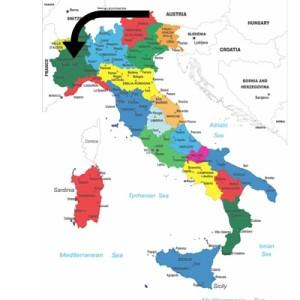 In nearby Piemonte, otherwise known as the Piedmont region, we find other mountainbased cheeses such as robiola, a sheep cheese, and tumin, a white mountain cheese served with red pepper and olive oil. Here, fonduta is the culinary pride – a fonduelike concoction of melted cheese that consists of milk, eggs and white truffles. Piedmont is also home to the popular porcini mushroom.
In nearby Piemonte, otherwise known as the Piedmont region, we find other mountainbased cheeses such as robiola, a sheep cheese, and tumin, a white mountain cheese served with red pepper and olive oil. Here, fonduta is the culinary pride – a fonduelike concoction of melted cheese that consists of milk, eggs and white truffles. Piedmont is also home to the popular porcini mushroom.
Lombardy Region
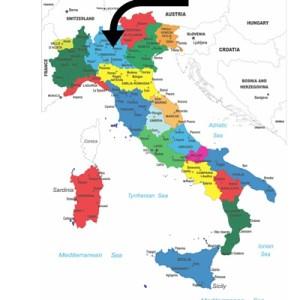 Within the Lombardy region, the diverse geography produces a number of famous dishes based on rice and grains, such as minestrone alla Milanese and risotto alla Milanese. Pumpkin ravioli is a specialty of Lombardy, as well as the veal dish osso bucco. The region is also known for certain famous soft, rich cheeses as gorgonzola and mascarpone.
Within the Lombardy region, the diverse geography produces a number of famous dishes based on rice and grains, such as minestrone alla Milanese and risotto alla Milanese. Pumpkin ravioli is a specialty of Lombardy, as well as the veal dish osso bucco. The region is also known for certain famous soft, rich cheeses as gorgonzola and mascarpone.
Trentino Alto Adige Region
 Moving east, we encounter the Trentino Alto Adige region, showing strong culinary influences from Germany and Hungary. Here we find gnocchi, perhaps inspired by potato dumplings of Germanic origin, as well as hearty soups and stews with red cabbage and paprika, not unlike Hungary’s goulash.
Moving east, we encounter the Trentino Alto Adige region, showing strong culinary influences from Germany and Hungary. Here we find gnocchi, perhaps inspired by potato dumplings of Germanic origin, as well as hearty soups and stews with red cabbage and paprika, not unlike Hungary’s goulash.
Veneto Region
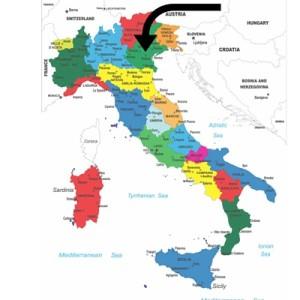 Next door, the Veneto region curves around the northern part of the Adriatic Sea, with cuisine featuring fresh seafood such as shrimp, eel, clam, and fish. The Veneto region also boasts some of Italy’s finest vegetable dishes, such as risi e bisi (rice and peas), radicchio di Treviso, grilled and served with salt and olive oil, and white asparagus boiled and served with vinaigrette. Perhaps the most famous cheese to come from the Veneto region is the hard, salty asiago.
Next door, the Veneto region curves around the northern part of the Adriatic Sea, with cuisine featuring fresh seafood such as shrimp, eel, clam, and fish. The Veneto region also boasts some of Italy’s finest vegetable dishes, such as risi e bisi (rice and peas), radicchio di Treviso, grilled and served with salt and olive oil, and white asparagus boiled and served with vinaigrette. Perhaps the most famous cheese to come from the Veneto region is the hard, salty asiago.
Friuli Venezia Region
 As we move toward the eastern boundary of the North, we encounter the cornfields of Friuli Venezia, where polenta is a popular staple. Known for its prosciutto di San Daniele, considered one of the best in Italy, FriuliVenezia cuisine, like Veneto cuisine, showcases influences from its Germanic and Slavic neighbors, with boiled pork, cabbage, potatoes, and goulash dumplings. Pastries in this region reflect an Austrian influence, with delicate fruits and pastry layers.
As we move toward the eastern boundary of the North, we encounter the cornfields of Friuli Venezia, where polenta is a popular staple. Known for its prosciutto di San Daniele, considered one of the best in Italy, FriuliVenezia cuisine, like Veneto cuisine, showcases influences from its Germanic and Slavic neighbors, with boiled pork, cabbage, potatoes, and goulash dumplings. Pastries in this region reflect an Austrian influence, with delicate fruits and pastry layers.
Liguria region
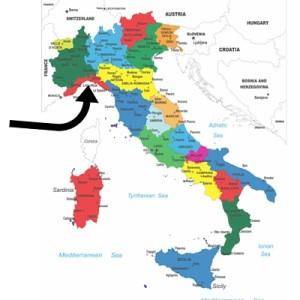 On the western boundary, the Liguria region is the diametric opposite of the FriuliVenezia, with a decidedly lighter, Mediterranean flavor. Mushroom, nuts, cod, and rabbit are all featured in the dishes of Liguria, with pesto being the most famous of the dishes from this region. Unlike other cuisines of Northern Italy, Liguria is known for its exquisite olive oil, which is a key in producing worldclass pesto. Liguria’s proximity to the ocean provides swordfish, sea bass, tuna, and sardines, which feature prominently in their cuisine as well.
On the western boundary, the Liguria region is the diametric opposite of the FriuliVenezia, with a decidedly lighter, Mediterranean flavor. Mushroom, nuts, cod, and rabbit are all featured in the dishes of Liguria, with pesto being the most famous of the dishes from this region. Unlike other cuisines of Northern Italy, Liguria is known for its exquisite olive oil, which is a key in producing worldclass pesto. Liguria’s proximity to the ocean provides swordfish, sea bass, tuna, and sardines, which feature prominently in their cuisine as well.

